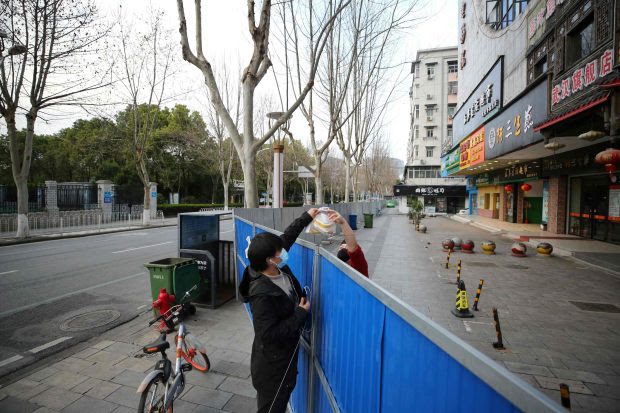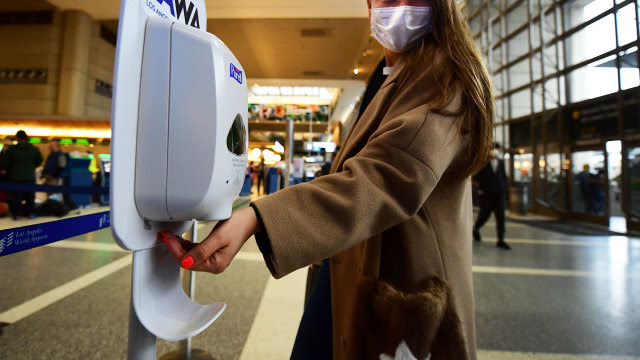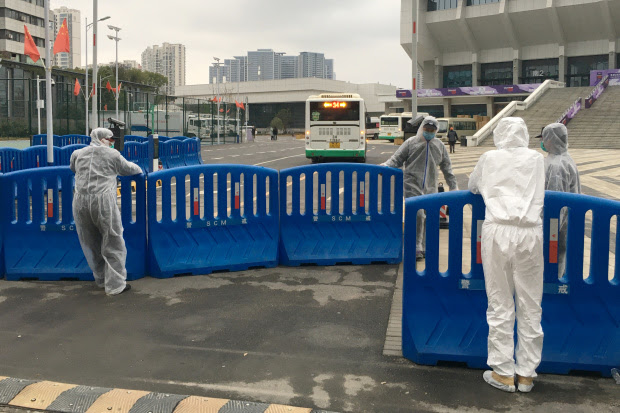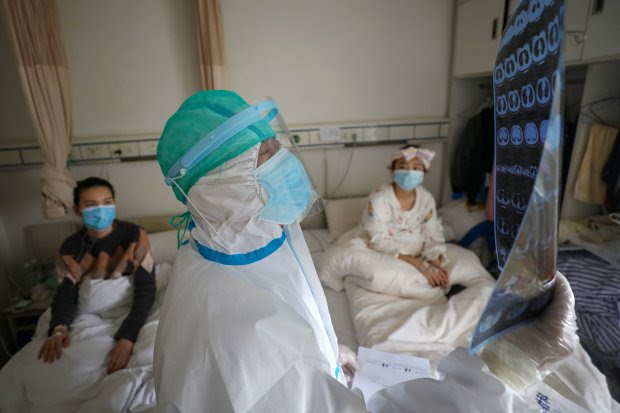General lockdowns aren’t enough, experts say, without systematic testing and quarantining of carriers
By Jeremy Page, WSJ, March 24, 2020 2:36 pm ET
The intensive-care unit at Wuhan pulmonary hospital on March 19.
Photo: Xiao Yijiu/Xinhua/Zuma Press
BEIJING—U. S. and European leaders are looking at China’s progress in curbing the coronavirus pandemic to guide them on how to beat the virus within their own borders.
They may be drawing the wrong lessons, doctors and health experts say.
The cordon sanitaire that began around Wuhan and two nearby cities on Jan. 23 helped slow the virus’s transmission to other parts of China, but didn’t really stop it in Wuhan itself, these experts say. Instead, the virus kept spreading among family members in homes, in large part because hospitals were too overwhelmed to handle all the patients, according to doctors and patients there.
What really turned the tide in Wuhan was a shift after Feb. 2 to a more aggressive and systematic quarantine regime whereby suspected or mild cases—and even healthy close contacts of confirmed cases—were sent to makeshift hospitals and temporary quarantine centers.
The tactics required turning hundreds of hotels, schools and other places into quarantine centers, as well as building two new hospitals and creating 14 temporary ones in public buildings. It also underscored the importance of coronavirus testing capacity, which local authorities say was expanded from 200 tests a day in late January to 7,000 daily by mid-February.
The steps went beyond what’s envisioned in many hard-hit Western cities. As a result, many doctors and experts say the recent lockdowns in the U.S. and Europe may slow the rise in new infections—if properly enforced—but still won’t be enough to stop it or prevent many hospitals from being overwhelmed, as they were initially in Wuhan.
“A lot of the lessons have been lost,” said Devi Sridhar, professor of global public health at the University of Edinburgh. “A lockdown helps buy time: The only way it will work is if you actually backtrack and start figuring out who has the virus.”
Share Your Thoughts
Do you think enough is being done to defeat the coronavirus where you live? Join the conversation below.
In New York City, federal authorities plan to set up mobile hospitals, with a total capacity of 1,000 beds, at the Jacob K. Javits Convention Center in Manhattan. New York has also been looking into converting entire hotels into hospitals, but it is unclear how many beds will be made available.
Zhang Jinnong, head of the emergency department at Wuhan’s Xiehe Hospital, said the most important thing was to separate the infected from the healthy, and recommended hotels as quarantine centers where people could be isolated in separate rooms.
“You just need to turn off the central air conditioning,” he said.
He also said that in recent days he saw a handful of patients who had developed antibodies to the virus without knowingly being infected. That suggested to him that Wuhan might have already developed a level of “herd immunity.”
More than 50,000 confirmed cases of coronavirus have been identified in Wuhan—61% of China’s total—since it was first detected in December, according to Chinese health authorities. Early cases mostly involved people connected to a food market selling wild animal meat.
The virus had killed 2,524 people in the city as of Tuesday, representing 77% of China’s national toll, and a mortality rate of almost 5%.
Since late February, however, the official number of new confirmed cases in Wuhan has been declining. In the past six days, it has reported only one, prompting Chinese authorities to close all temporary hospitals and start relaxing the lockdown.
China said on Tuesday that from Wednesday it would relax its mass quarantine to allow healthy people to leave the central province of Hubei, except Wuhan, its capital, where travel restrictions would be similarly eased on April 8.
Many foreign governments that initially ruled out lockdowns, saying they wouldn’t work in democracies, are now implementing similar, though less draconian, restrictions, but without corresponding efforts to identify and isolate cases.
Some foreign experts and officials are skeptical of Wuhan as a model. They cite local authorities’ early efforts to cover up the scale of the problem, and the fact that more than five million people were able to leave Wuhan in the run-up to the lockdown.

Some also still have doubts about China’s official figures. Wuhan’s health commission said on Monday that asymptomatic cases were being isolated in quarantine centers but not included in the public tally of confirmed cases, even if they tested positive.
Others think China could suffer a big second wave of infections if it continues to relax curbs on travel and work, and that the Chinese approach would be too economically costly to replicate.
Among doctors and residents in Wuhan, meanwhile, some feel the lockdown of the city was too sudden and strict, as well as too late, and contributed to the high mortality rate there as hospitals were ill-prepared for the flood of patients that followed.
Many medical workers were also infected because they initially lacked protective gear and infectious disease training, doctors and nurses in Wuhan say.
Still, the more systematic quarantine and testing regime in Wuhan after Feb. 2 is similar to measures that also appear to have been effective in South Korea and Singapore, according to many experts.

On Dec. 1, 2019, a patient in Wuhan, China, started showing symptoms of what doctors determined was a new coronavirus. Since then, the virus has spread to infect more than 100,000 people. Here’s how the virus grew to a global pandemic. Photo: Getty Images
South Korea, which has tested more people than any other country, originally tried to hospitalize all confirmed cases. But as wards became overloaded, from March 1 it divided coronavirus patients into four categories: asymptomatic, mild, severe and critical.
Only severe and critical cases were hospitalized, while mild and asymptomatic cases were placed in makeshift hospitals known as “residential treatment facilities.”
In Singapore, all suspected cases have been isolated in hospitals, while close contacts of confirmed cases have been systematically tracked and quarantined in government-run facilities or at home.
Mike Ryan, the World Health Organization’s emergencies head, warned on Sunday that lockdowns wouldn’t be enough to control the pandemic and urged governments to focus on identifying and isolating infected people and their contacts.
“It’s not just about physical distancing, it’s not just about locking down,” he said. “In China, and in Singapore, in Korea, they really focused on having that comprehensive strategy.”
“We must isolate separately those with disease who need immediate medical attention, those known to be infected who have no or only mild disease, those who are suspected to be infected based on exposure history, and those who have no known exposure and are well,” he said. Chinese authorities did aim to filter cases when it first locked down Wuhan on Jan. 23. Confirmed and suspected cases were supposed to be quarantined in hospitals, with close contacts self-isolating at home. The problem was that local hospitals, which had just 4,000 beds for suspected and confirmed cases, were soon overwhelmed by patients. Experts using mathematical models estimated at the time there were already tens of thousands of people infected. By Jan. 27, some 15,000 people were going to the city’s fever clinics every day, more than five times the usual number, according to the official Xinhua News Agency. Many were sent home without being tested. By early February, there were 20,629 people quarantining themselves at home having visited fever clinics—and that excluded sick people who hadn’t yet visited a hospital, Hu Lishan, the city’s vice party secretary, told a news briefing. “We feel very worried and distressed,” he said, likening the pent-up demand for hospital space to a “dammed lake.” The critical change came on Feb. 2, when Wuhan’s health authorities tasked community leaders with dividing cases into different categories, sending only confirmed patients to hospitals, and others to makeshift hospitals or quarantine centers. Under the new policy, which took some two weeks to implement, suspected cases were also quarantined separately from other categories such as those recently discharged from the hospital and those who had close contact with confirmed cases, local officials and doctors say. Some 12,000 people ended up staying in temporary hospitals. “When you have the opportunity to isolate all suspected patients and close contacts, this is the turning point of the outbreak here in Wuhan,” said Du Bin, head of the intensive care unit at Peking Union Hospital, who has been working in Wuhan in recent weeks. He also echoed the World Health Organization in stressing the importance of testing. “Apart from testing, I just have no idea how you can identify the suspected cases and how to quarantine the close contacts.” Health-care workers from Xi’an International Medical Center Hospital bid farewell to their colleagues before setting off for Wuhan in early February. He arrived in Wuhan on Feb. 9 and was put to work in an exhibition center newly transformed into a makeshift hospital with 40 doctors and 1,461 beds, for confirmed mild coronavirus cases. Separating milder cases “is a great way to save resources,” he said, adding that five doctors were able to look after 400 patients during each shift. His daily routine included checking patients’ vital signs, giving them medication, conducting tests, and identifying those developing severe symptoms. After about two weeks, he said, his team noticed that about 10%-15% of patients discharged from some makeshift hospitals were later testing positive again—a possible indication they hadn’t fully cleared the virus. On Feb. 22, Wuhan required all discharged patients to go to quarantine sites for another two weeks instead of heading home. Health experts say other countries short of testing kits can also learn from Wuhan’s experience. Unable to test thousands of suspected cases, on Feb. 4, health authorities allowed doctors to use chest scans to make coronavirus diagnoses in Hubei. A medical worker in protective gear inspects a CT scan image at a ward of Wuhan Red Cross Hospital in Wuhan. A recent study led by doctors at Wuhan’s Tongji Medical College estimated that the reproduction number of the virus—the average number of people infected by each infected person—was about 3.68 in Wuhan before the lockdown began on Jan. 23. That number, which has to be reduced to below one to stop an epidemic, dropped to 0.32 between Feb. 2 and 18, the study found. —Fanfan Wang and Qianwei Zhang in Beijing contributed to this article.
After Wuhan closed its supermarkets, workers had to deliver prepackaged bags of food to residents.
Ian Lipkin, an infectious disease expert at Columbia University who visited China in January and has been advising health officials there, says the U.S. should immediately implement a nationwide stay-at-home policy and then move to a “stratified isolation system” until a vaccine is ready.
Photo: Zhang Bowen/XINHUA/Zuma Press
Another critical factor was the deployment to Wuhan of thousands of extra doctors and nurses from elsewhere in China. Among them was Meng Xinke, a doctor from the intensive care department of the No. 2 People’s Hospital in Shenzhen.
Photo: china daily/Reuters
That resulted in a spike in confirmed cases, stunning the outside world. By Feb. 19, however, the number of newly confirmed cases in Wuhan had dropped into the hundreds and by March 11, it was down to single digits. The number of deaths has declined steadily since Feb. 18.








Leave a Reply
You must be logged in to post a comment.